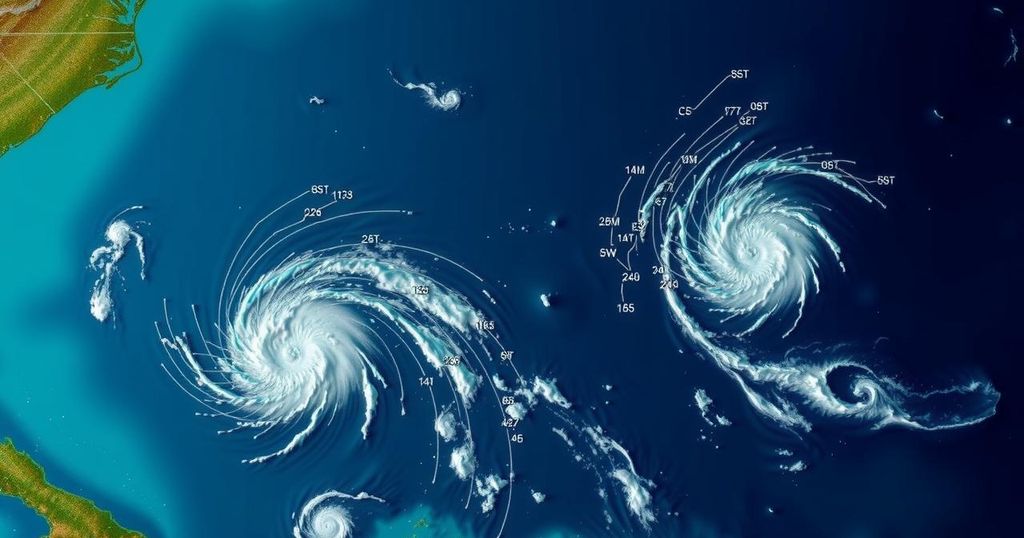Global news
ACCUWEATHER, ALAN REPPERT, ATLANTIC, COLOMBIA, CUBA, EVACUATIONS, FLORIDA, HURRICANE, HURRICANE BERYL, NATIONAL HURRICANE CENTER, NATURAL DISASTER, NEWSWEEK, NHC, NORTH AMERICA, POWER OUTAGES, PUERTO RICO, RAFAEL, REP, REPPERT, SARA, SOUTH AMERICA, TROPICAL STORM SARA, WEATHER
Marcus Li
0 Comments
Hurricane Rafael May Hinder Development of Tropical Storm Sara
Chances for the formation of Tropical Storm Sara are increasing in the southwestern Atlantic, yet Hurricane Rafael may inhibit this development. Rafael is anticipated to strengthen into a major hurricane before impacting Cuba and subsequently move into the Gulf. AccuWeather meteorologists express skepticism regarding the new storm’s development due to Rafael’s proximity. The area is expected to experience rainfall regardless of the formation of Sara.
Recent developments in the southwestern Atlantic indicate a gradual increase in the probability of a system evolving into Tropical Storm Sara. However, Hurricane Rafael, located to the west, poses a potential disruption to this development. Having reached hurricane status on Tuesday night, Rafael is projected to strengthen further before making landfall in Cuba on Wednesday. Currently classified as a Category 2 hurricane, with maximum sustained winds of 115 mph, Rafael is expected to weaken upon moving over Cuba but could retain hurricane strength once it exits into the Gulf. As per the National Hurricane Center (NHC), the system in the southwestern Atlantic is estimated to have a 30 percent chance of transforming into Tropical Storm Sara within the next seven days and a 20 percent chance over the next 48 hours. If it indeed forms, it will mark the eighteenth named storm in the 2024 Atlantic hurricane season. Nonetheless, meteorologists from AccuWeather have observed that Rafael’s proximity substantially lowers the likelihood of this development, suggesting the storm may inhibit any strengthening of the system. AccuWeather senior meteorologist Alan Reppert provided insight, stating that Rafael could hinder the development of the new system, noting, “It looks like the odds of this developing are not in its favor because of the overall environment and also Rafael being there. For this to develop, it will have to have some good fortune.” Should Tropical Storm Sara emerge, it may significantly affect the northern Caribbean and the southern Bahamas, with potential impacts aimed at Florida. The NHC recently commented on the disorganized system, stating, “A trough of low pressure is producing an area of disorganized showers and thunderstorms a few hundred miles east-northeast of the Leeward Islands.” This system is expected to generally move westward, with a low-pressure area possibly forming near the northern Leeward Islands shortly. While some gradual development may occur towards the end of the week, independent of its formation, the system is anticipated to produce rain across the northern central Caribbean and the southern Bahamas. Despite Hurricane Rafael’s strengthening possibly lessening the immediate threat to Florida from another approaching storm, it could introduce indirect threats including coastal flooding and potential tornadoes in the Florida Keys as it passes nearby. Anna Skinner, a senior reporter with Newsweek, specializes in climate and environmental reporting, focusing on natural disasters. Having joined Newsweek in 2022, she has extensive experience in the field.
The article addresses the evolving situation in the Atlantic during hurricane season, particularly focusing on the potential development of a new tropical storm, Tropical Storm Sara, and the influence of Hurricane Rafael on this process. The National Hurricane Center provides data on these systems, informing on their strength, movements, and potential impacts, highlighting the complexity and unpredictability of hurricane forecasting processes. Insight from meteorologists enhances the understanding of oceanic and atmospheric dynamics at play during such weather events.
In conclusion, while conditions for the development of Tropical Storm Sara increase, Hurricane Rafael’s presence presents significant challenges to this potential evolution. Meteorologists emphasize the low probability of the new storm forming due to environmental interactions with Rafael. Nevertheless, whether it forms or not, rainfall is expected across several Caribbean regions, with Rafael bringing additional concerns to the Florida area regarding flooding and severe weather. Continuous monitoring by the National Hurricane Center and various meteorological agencies is crucial in understanding the trajectory and potential impacts of these storms.
Original Source: www.newsweek.com




Post Comment